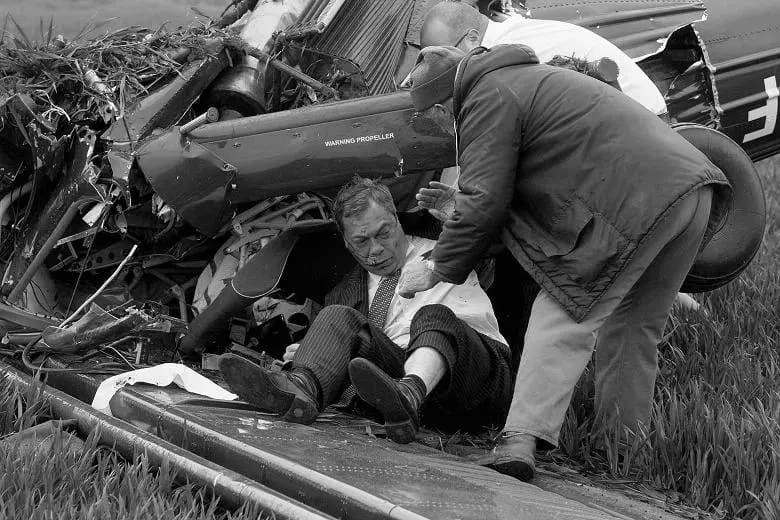Inside the 2010 election-day crash that nearly killed him — and what investigators discovered.
In May 2010, on the morning of the UK general election, Nigel Farage survived a serious light-aircraft crash that could easily have been fatal. The incident, which happened in Hinton-in-the-Hedges, Northamptonshire, left him with broken ribs, a punctured lung and spinal injuries. The plane accident became part of Farage’s political mythology.
The election-day flight
At the time, Farage was leader of the UK Independence Party (UKIP) and standing as a parliamentary candidate in Buckingham. On 6 May 2010, he boarded a small two-seat aircraft towing a UKIP banner that read Vote for Your Country – Vote UKIP
. The flight was intended as an election-day publicity stunt.
Shortly after take-off, at about 8 am, the plane lost control and crashed nose-first into a field. Witnesses described the wreckage as “crumpled like a tin can.” Farage was trapped in the cockpit while the pilot, Justin Adams, was also seriously injured.
Immediate aftermath
Emergency services air-lifted both men to hospital. Farage suffered several fractures, facial injuries, and a punctured lung but remained conscious and reportedly joked with rescuers. The image of him bloodied but alive, wearing his trademark pinstripe suit, made front-page news across Britain that day.
Within hours, Farage released a statement thanking paramedics and well-wishers, saying he felt “incredibly lucky to be alive.” According to The Guardian, doctors later told him that a few centimetres’ difference in impact could have been fatal.
What the investigation found
The Air Accidents Investigation Branch (AAIB) conducted a full inquiry. Its official report concluded that the crash was caused by the banner becoming entangled around the aircraft’s tailplane and rudder, making it uncontrollable.
The report stated that “the banner cable wrapped around the tail, rendering the elevators ineffective.” The pilot had tried to release the banner but the mechanism failed, leaving no way to regain control. The aircraft hit the ground at about 70 mph, flipping over on impact.
No mechanical fault was found with the plane itself. Investigators emphasised that such banner-towing flights were inherently risky because of low altitude and the complexity of releasing banners mid-flight.
The pilot’s later legal troubles
Pilot Justin Adams later became embroiled in personal difficulties and was convicted in 2011 for threatening Farage, whom he blamed for the loss of his flying career. Farage told the BBC he found the situation “tragic” and said he wished Adams “a full recovery.”
Recovery and political comeback
Farage returned to work within weeks, appearing at the 2010 UKIP conference with visible scars but his trademark humour intact. In his memoir The Purple Revolution (2015), he described the crash as “the closest brush with death I hope ever to have,” adding that it made him “less afraid of anything else.”
He wrote:When you’ve seen the earth rush up at you through a windscreen, and somehow walked away, a lot of things that seemed important stop mattering.
Supporters later framed the accident as symbolic of Farage’s resilience — a moment that reinforced his “survivor” image both literally and politically.
Legacy of the accident
While the 2010 crash had no lasting effect on Farage’s physical mobility, it became part of his personal narrative of endurance. He has since joked in interviews that he’s “run out of lives.” The AAIB report remains a textbook example in flight-safety circles of how banner-towing can go wrong.
In the years that followed, Farage continued to fly as a passenger but has reportedly avoided small aircraft. “Once is enough,” he told The Telegraph in 2016.
Final thoughts
Nigel Farage’s 2010 accident was caused not by recklessness or sabotage but by mechanical misfortune — a campaign banner snagging a tailplane cable. It nearly ended his life but added to his legend. For an anti-establishment politician, surviving a crash and returning to fight another day became its own kind of metaphor.

